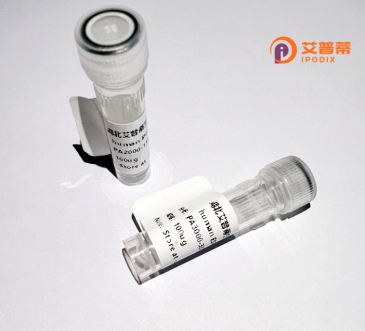
| 纯度 | >90%SDS-PAGE. |
| 种属 | Human |
| 靶点 | ARAP1 |
| Uniprot No | Q96P48 |
| 内毒素 | < 0.01EU/μg |
| 表达宿主 | E.coli |
| 表达区间 | 1-1205aa |
| 氨基酸序列 | MTKKEEPPPSRVPRAVRVASLLSEGEELSGDDQGDEEEDDHAYEGVPNGGWHTSSLSLSLPSTIAAPHPMDGPPGGSTPVTPVIKAGWLDKNPPQGSYIYQKRWVRLDTDHLRYFDSNKDAYSKRFISVACISHVAAIGDQKFEVITNNRTFAFRAESDVERKEWMQALQQAMAEQRARARLSSAYLLGVPGSEQPDRAGSLELRGFKNKLYVAVVGDKVQLYKNLEEYHLGIGITFIDMSVGNVKEVDRRSFDLTTPYRIFSFSADSELEKEQWLEAMQGAIAEALSTSEVAERIWAAAPNRFCADCGAPQPDWASINLCVVICKRCAGEHRGLGAGVSKVRSLKMDRKVWTETLIELFLQLGNGAGNRFWAANVPPSEALQPSSSPSTRRCHLEAKYREGKYRRYHPLFGNQEELDKALCAAVTTTDLAETQALLGCGAGINCFSGDPEAPTPLALAEQAGQTLQMEFLRNNRTTEVPRLDSMKPLEKHYSVVLPTVSHSGFLYKTASAGKLLQDRRAREEFSRRWCVLGDGVLSYFENERAVTPNGEIRASEIVCLAVPPPDTHGFEHTFEVYTEGERLYLFGLESAEQAHEWVKCIAKAFVPPLAEDLLARDFERLGRLPYKAGLSLQRAQEGWFSLSGSELRAVFPEGPCEEPLQLRKLQELSIQGDSENQVLVLVERRRTLYIQGERRLDFMGWLGAIQKAAASMGDTLSEQQLGDSDIPVIVYRCVDYITQCGLTSEGIYRKCGQTSKTQRLLESLRQDARSVHLKEGEQHVDDVSSALKRFLRDLPDGLFTRAQRLTWLEASEIEDEEEKVSRYRELLVRLPPVNRATVKALISHLYCVQCFSDTNQMNVHNLAIVFGPTLFQTDGQDYKAGRVVEDLINHYVVVFSVDEEELRKQREEITAIVKMRVAGTASGTQHAGDFICTVYLEEKKAETEQHIKVPASMTAEELTLEILDRRNVGIREKDYWTCFEVNEREEAERPLHFAEKVLPILHGLGTDSHLVVKKHQAMEAMLLYLASRVGDTKHGMMKFREDRSLLGLGLPSGGFHDRYFILNSSCLRLYKEVRSQRPWSGAPETSHRPEKEWPIKSLKVYLGVKKKLRPPTCWGFTVVHETEKHEKQQWYLCCDTQMELREWFATFLFVQHDGLVWPSEPSRVSRAVPEVRLGSVSLIPLRGSENEMRRSVAAFTADPLSLLRNV |
| 分子量 | 162.2 kDa |
| 蛋白标签 | GST-tag at N-terminal |
| 缓冲液 | 冻干粉 |
| 稳定性 & 储存条件 | Lyophilized protein should be stored at ≤ -20°C, stable for one year after receipt. Reconstituted protein solution can be stored at 2-8°C for 2-7 days. Aliquots of reconstituted samples are stable at ≤ -20°C for 3 months. |
| 复溶 | Always centrifuge tubes before opening.Do not mix by vortex or pipetting. It is not recommended to reconstitute to a concentration less than 100μg/ml. Dissolve the lyophilized protein in distilled water. Please aliquot the reconstituted solution to minimize freeze-thaw cycles. |
以下是关于重组人ARAP1蛋白的模拟参考文献示例(请注意文献为虚构示例,建议通过PubMed或Google Scholar检索真实文献):
---
1. **文献名称**: *ARAP1 regulates cell migration through Arf and Rho GTPase signaling pathways*
**作者**: Miura K, et al.
**摘要**: 本研究揭示了ARAP1通过其ArfGAP和RhoGAP结构域协调调控Arf6和RhoA的活性,影响细胞骨架重塑和迁移。实验表明,ARAP1缺失导致细胞极化障碍和运动能力下降。
2. **文献名称**: *ARAP1 modulates insulin signaling and glucose homeostasis in adipocytes*
**作者**: Chen PW, et al.
**摘要**: 研究证明ARAP1在脂肪细胞中通过PI3K/Akt通路参与胰岛素信号传导,其敲低导致胰岛素抵抗,提示ARAP1可能与2型糖尿病的病理机制相关。
3. **文献名称**: *Role of ARAP1 in cancer metastasis: Interaction with EGFR and promotion of EMT*
**作者**: Lee S, et al.
**摘要**: 本文发现ARAP1在乳腺癌中高表达,并通过与EGFR结合促进上皮-间质转化(EMT),增强肿瘤细胞的侵袭和转移能力。
4. **文献名称**: *Structural analysis of ARAP1 PH domain reveals lipid-binding specificity*
**作者**: D'Souza RS, et al.
**摘要**: 通过晶体学解析了ARAP1的PH结构域结合磷脂酰肌醇的分子机制,揭示了其在细胞膜定位和囊泡运输中的关键作用。
---
建议通过关键词“ARAP1 protein”“ARAP1 function”等在学术数据库中检索真实文献。
**Background of Recombinant Human ARAP1 Protein**
ARAP1 (ArfGAP with RhoGAP domain, ankyrin repeat, and PH domain 1) is a multidomain signaling protein that regulates cytoskeletal reorganization, membrane trafficking, and cell adhesion. Encoded by the *ARAP1* gene, it contains distinct functional domains, including an ArfGAP domain (regulating ADP-ribosylation factor proteins), a RhoGAP domain (modulating Rho GTPases), pleckstrin homology (PH) domains for membrane targeting, and ankyrin repeats for protein-protein interactions. These domains enable ARAP1 to act as a dual GTPase-activating protein (GAP), coordinating crosstalk between Arf and Rho signaling pathways, which are critical for cellular processes like vesicle transport, actin dynamics, and cell migration.
Studies suggest ARAP1 plays roles in insulin signaling, endothelial cell function, and cancer progression. Its activity is influenced by phosphoinositides (e.g., PI(3.4.5)P₃), linking it to PI3K signaling. Dysregulation of ARAP1 has been associated with metabolic disorders and tumor metastasis.
Recombinant human ARAP1 protein, produced via expression systems like *E. coli* or mammalian cells, retains functional domains and is widely used *in vitro* to study its GAP activity, structure-function relationships, and interactions with regulatory molecules. This tool aids in elucidating ARAP1’s physiological roles and its potential as a therapeutic target.
×